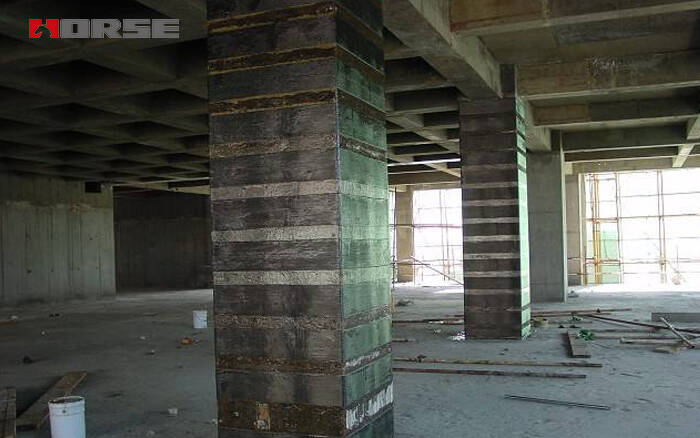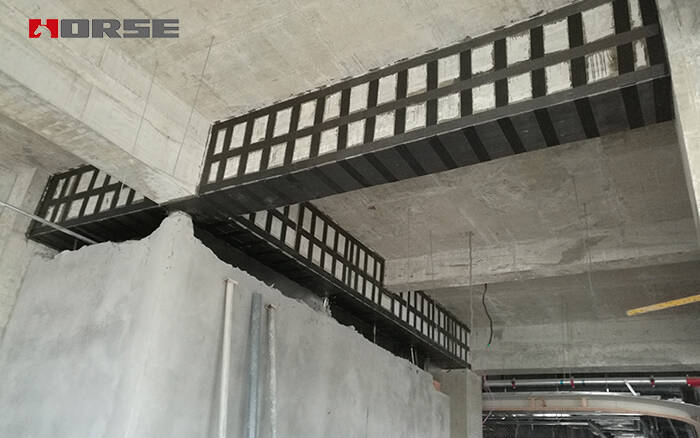A Concete Factory Reinforcement
Unidirectional Carbon Fiber Materials
The unidirectional carbon fiber material strengthens the concrete structure, which has the advantages of high strength, high efficiency, and convenient construction. This article specifically introduces the design and construction process of carbon fiber reinforced reinforced concrete columns through engineering examples, and briefly explains other applications of carbon fiber materials in concrete reinforcement.

1. Project Overview
The factory building in an industrial zone was originally an 8-story frame structure. The section of the reinforced concrete column was 500mmx500mm, and the concrete strength grade was C30. A total of 12 25-level II steel bars were arranged along the periphery of the column. The plant reinforcement project was tested to be unable to meet the requirements of the original structure bearing and seismic fortification. After the design and research institute's structural reinforcement design, it is planned to use carbon fiber reinforcement technology to strengthen the flexural strength of some of the 1-2 floors. At the same time, due to the long-term erosion of acid and alkali and other gases, the concrete protective layer has partially peeled off, and the ribs have been partially rusted. The horizontal restraint of the concrete needs to be reinforced.
2. Determine the reinforcement plan
After comparative analysis, it was decided to use the method of pasting unidirectional carbon fiber cloth to improve the bearing capacity and ductility of the column. For this project, the use of this reinforcement technology is mainly because the unidirectional carbon fiber cloth and the bonding steel method have the following advantages:
2.1. High strength, thin and light, almost no increase in structural weight and section size. The tensile strength of carbon fiber sheet is 7-10 times that of steel with the same cross-section. The thickness of the finished sheet is only 0.111mm-0.333mm, and its bulk density is 1/4-1/5 of steel. And it is flexible, easy to cut, and has a wide range of applications, suitable for any shape
2.2. Anti-corrosion of acid, alkali and salt media, fatigue resistance, creep resistance, stable material size, reinforcement can greatly improve the corrosion resistance and durability of the structure, and can be applied to reinforcement of components in various working environments.
2.3. The construction is simple and fast. The unidirectional carbon fiber sheet can be directly pasted and wrapped on the surface of the building, the process is simple, no formwork and large-scale hoisting equipment are required, and the requirements for the construction site are low, and it is suitable for narrow space operations. Easy to operate and economical.
2.4. It can effectively close the cracks of the concrete structure and prolong the service life of the structure.
2.5. The use of unidirectional carbon fiber sheets for reinforcement can keep the appearance of the original structure as much as possible without affecting the surface decoration and minimizing the traces of repair.
Design calculation: This project is a frame structure with seismic grade two, column section 500x500, existing stirrup 8@200, concrete strength grade C30, and the column axial compression ratio is now 0.9. By pasting two layers of carbon fiber cloth horizontally, the axial pressure ratio is reduced to no more than 0.8, which meets the requirements of seismic codes. The calculation process is as follows: the influence of column longitudinal reinforcement is not considered.
As=bh-(4-1π)Rc2=249463mm2
Ks=(blh) [ 1-[ (b/h) (h-2Rc)2+(b/h) (b-2Rc)]/(3Ag-ps/1-ps)=0.46,
Adopting two-layer carbon fiber cloth paste: the first layer is pasted longitudinally along the axis of the column to improve the bending strength of the column. The second layer is wrapped laterally along the column to enhance the compressive strength, ductility and seismic performance of the column. Considering that with the same amount of carbon fiber cloth, the effect of strip wrapping is better than the effect of whole wrapping. At the same time, combined with the cross-sectional size of the column, it is decided to stick a carbon fiber cloth with a width of 300mm on each surface along the axial direction of the column, and the lap length is 250mm. Wrap a 300mm wide carbon fiber cloth every 100mm along the column height, with an overlap length of 250mm.
3. Carbon fiber material construction process and operation requirements
The process flow is: preparation before construction, concrete surface treatment, primer coating, leveling, pasting, and protection.

4. Other applications of unidirectional carbon fiber materials in the reinforcement of concrete structures
Carbon fiber reinforcement technology can be applied not only to the reinforcement of concrete structures in housing engineering, railway engineering, highway engineering, bridge engineering, port engineering, and water conservancy and hydropower engineering, but also to the reinforcement of masonry structures and wood structures. The specific applications of carbon fiber sheet repair and reinforcement concrete structure technology in engineering include:
4.1. Reinforce the tension zone of beams, slabs and other bending members (the lower part of the span, the upper part of continuous beams and slab supports). With the reinforcement of carbon fiber, the bearing capacity of the bending member is increased. The cracks in the tension zone can be sealed with a carbon fiber sheet after filling the joints to control the continued expansion of the cracks. In addition, for the reinforcement of the bending member, the method of prestressing the carbon fiber can also be used to improve the reinforcement effect.
4.2. Shear reinforcement of beams: For oblique cracks caused by main tensile stress, carbon fiber sheets are pasted on the vertical axis of the beam side, and unidirectional fiber sheets can be cross-bonded if necessary.
4.3. For the pier column structure, use unidirectional carbon fiber sheets to be pasted on the positions where the main reinforcement or the lug reinforcement is insufficient. Because carbon fiber can effectively restrain the lateral deformation of the column, improve the strength and toughness of the pier column, thereby improving its seismic performance.
4.4. Shear walls are pasted with carbon fiber along the direction of the shear reinforcement on one or both sides.
4.5. High-rise structures (such as bacon, silos, water towers)-similar to the force conditions and reinforcement methods of piers.
4.6. Side walls of pools and gas tanks-reinforced by tension.
4.7. Culverts and tunnels-bending and tensile reinforcement under abnormal stress conditions.
4.8. Sealing function-the unidirectional carbon fiber sheet is pasted on the seam to make the carbon fiber and the concrete work together to extend the service life of the concrete component.